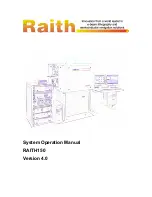
Form V372, Rev. 12
- 14 -
12/18, ECN4334
pump he is going to assume that mixing is taking place, but if the pump is gas bound, there
may be little or no mixing occurring. The best way for the operator to know if the mixing
system is not gas bound and operating normally is to check regularly on the differential
pressure across the pump and on the motor amperage to make sure they are normal. During
gas binding, pump differential pressure falls, sometimes to zero, and motor amperage also
falls, since the pump will be doing less flow work. If the system is allowed to run too long with
the mixing pump gas bound, big scum or sludge layers can build up in the tank during poor or
non-existent mixing. Also, equipment life may be reduced and/or risk of nozzle plugging
increased.
a. Vaughan Co. recommends the installation of a suitable air/gas release valve (ARV) for
each mixing pump. Note that an ARV cannot vent gas from a gas-bound, operating
pump. The rotation of the pump traps air at the impeller center. To vent air or gas from a
pump, it must be shut down. Some operators will resist the installation of ARVs because
these devices may need to be backflushed periodically, but the problems from loss of
mixing can be much more troublesome than periodically cleaning an ARV.
b. To properly vent air or gas from the pump by an ARV, the ARV must be mounted close
to and above the pump and not isolated by a valve or check valve that might close. Any
check valve, if used, should be located downstream of the ARV and pump.
B.
Poor mixing performance from the Rotamix™ system may be caused by plugged or blocked
nozzles as discussed in 2A above.
C. Foaming and Rapid Volume Expansion (RVE) problems in a digester are one of the most
common problems facing an operator of a modern anaerobic digester. Mixing increases
Volatile Solids Reduction or VSR and this means that more gases of decomposition
–
methane and carbon dioxide
– are generated. We want high VSR for better digestion, and we
want more gas for cogeneration of electricity. However, generating too much gas in a digester
over too little time can lead to foaming, RVE issues, and possible digester overflows. Digester
overflow means bad odors, a big cleanup, and complaints from residential neighbors.
a. Troubleshooting foaming or RVE problems can be difficult because the causes of these
problems are complex.
b. Many of the causes of foaming and RVE are out of Vaughan Co
.’s control, such as:
i. Feeding a digester in slugs rather than continuously. The best way to avoid foaming
is to spread out the feeding of new sludge over as much time as possible.
ii. High grease content. The feeding of grease or other high strength waste into a
digester generates a lot of gas and must be metered into the digester at a slow
enough rate to avoid upsetting the digester.
iii. The presence of Nocardia or Microthrix Parvicella from the secondary (aeration)
plant. When these bacteria from aerobic digestion are broken down in an anaerobic
digester, more gas is generated.
iv. High levels of WAS in feed sludge. WAS is Waste Activated Sludge from the aerobic
digestion, secondary side of the plant. WAS usually has some amount of Nocardia or
Microthrix Parvicella as well as undigested sludge. As the bacteria and sludge are
digested further, they will generate more gas.
v. Excessive alkalinity & CO
2
content in digester gas. More CO
2
gas can generate more
foam or cause RVE events.
vi. Volatile Fatty Acids (VFA), which can be caused by primary sludge fermentation prior
to feeding. This situation can lead to more rapid release of gases of decomposition.
vii. Feeding chemical sludge to digester, which could be the result of coagulant use
upstream of digestion. When these chemicals break down in the digester they
release more gas.
viii. Polymer overdose during dewatering. Again, when these polymers break down in the
digester they release more gas.



































